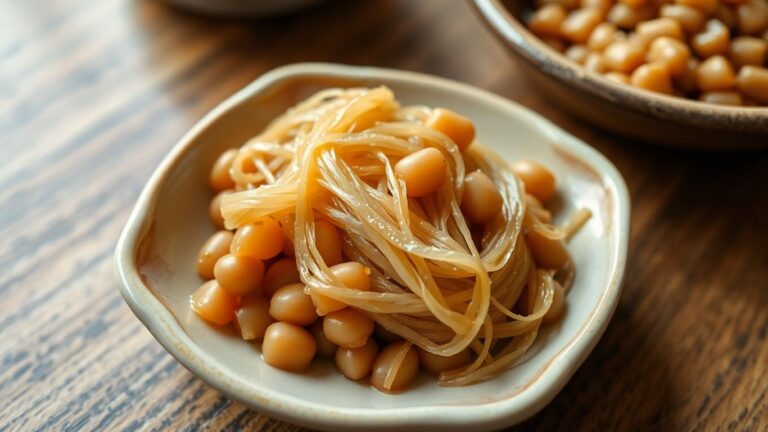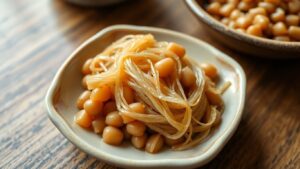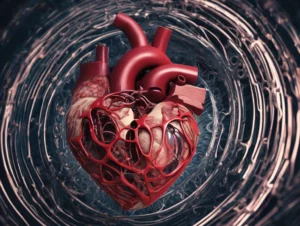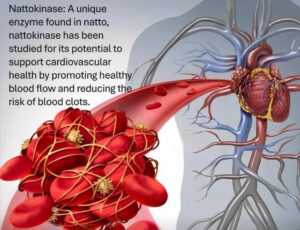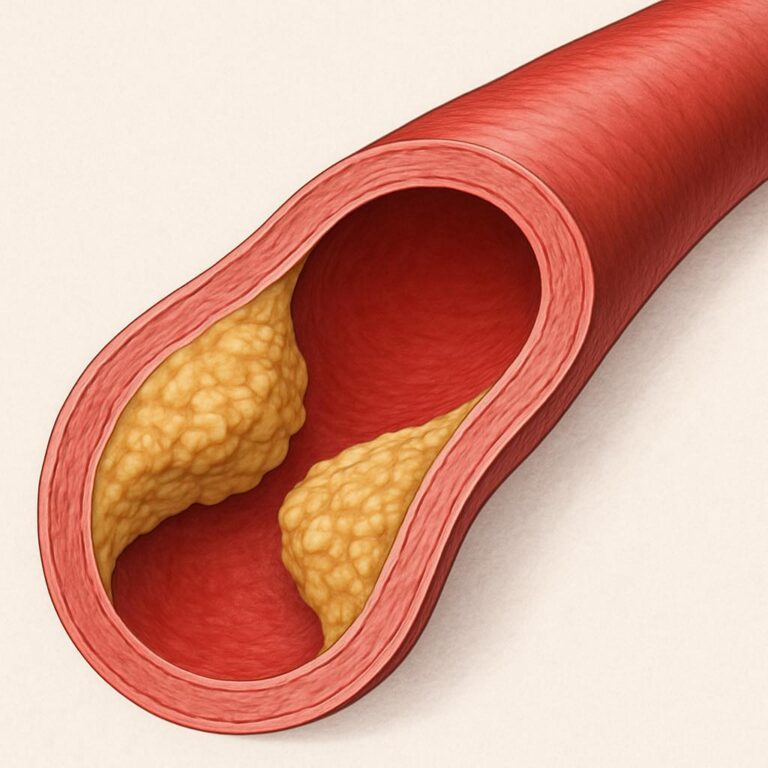Nattokinase is an enzyme you mostly find in a traditional Japanese food called natto, which is made from soybeans fermented with a special bacteria. People have started talking about nattokinase a lot because of its possible effects on heart health. It’s available as a supplement now, and some folks are interested in it for things like blood pressure, cholesterol, and blood clots. But, like with any supplement, there’s a lot to consider before jumping in.
Key Takeaways
- Nattokinase is an enzyme from fermented soybeans, originally found in the Japanese food natto.
- It may help with heart health by supporting blood flow, lowering blood pressure, and reducing blood clots.
- Studies in animals and people suggest nattokinase could have benefits, but results are mixed and more research is needed.
- There are possible side effects, like bleeding or allergic reactions, especially if you take blood thinners.
- If you’re thinking about using nattokinase supplements, talk to your healthcare provider first to make sure it’s safe for you.
What Is Nattokinase and Where Does It Come From
Nattokinase is well known for its unique ability to break down certain proteins in the body. This enzyme is derived from a traditional Japanese food called natto, which is made from fermented soybeans. People often turn to nattokinase because of its connection to heart and blood vessel health, but before we get to those details, let’s unravel where it starts and how you might find this enzyme today.
Origins in Japanese Fermented Foods
Natto isn’t just your average soybean dish. For centuries, it’s been a regular at Japanese breakfast tables. What makes natto stand out is how it’s created: soybeans are wrapped and then fermented with a specific bacteria, giving them a sticky, stringy texture and an acquired taste and smell. This bacteria is the real star here—it produces the nattokinase enzyme during fermentation.
- Natto has been eaten for hundreds of years in Japan.
- Fermentation occurs by introducing Bacillus subtilis var. natto.
- This process gives natto its unusual flavor and nutritious boost.
Eating natto means you’re getting nattokinase as a natural part of your diet, which some people prefer over taking supplements.
Role of Bacillus subtilis Natto
The fermentation magic comes from a bacterium called Bacillus subtilis natto. Once added to cooked soybeans, it gets to work, producing nattokinase and other enzymes. While there’s a lot going on inside that sticky mass, nattokinase is the main player when it comes to possible health benefits.
- Bacillus subtilis natto is key for nattokinase production.
- The bacteria transform plain soybeans into a nutrient-rich food.
- Only natto—among all soyfoods—naturally contains nattokinase.
Forms of Nattokinase Products
Most people outside Japan aren’t keen on natto’s strong aroma or taste, so nattokinase is often found in supplement form. You’ll notice a few main options on store shelves or online:
| Form | Description |
|---|---|
| Capsules | Easy to swallow; most common |
| Tablets | Convenient; may contain binders |
| Powders | Can be mixed with food or drinks |
- Some supplements use vegan-friendly ingredients.
- Dosage and absorption might change depending on form.
- Not all products are created equal—quality varies a lot between brands.
If you’re looking at nattokinase supplements, always read the label closely. Look for dosage information, and don’t hesitate to ask a healthcare professional about what’s best for you.
How Nattokinase Supports Heart Health

Nattokinase has caught the attention of people looking for natural ways to take care of their heart. This enzyme, found mostly in the Japanese food natto, may help with a few important heart and blood vessel issues. Let’s look at the main ways nattokinase supports cardiovascular health.
Mechanisms in Blood Clot Dissolution
One of the main benefits of nattokinase is its effect on blood clots. Nattokinase works directly to break down fibrin, the main protein involved in clot formation. This process may help the body dissolve clots that have already formed and prevent new ones from blocking blood flow. Here’s a quick list of what nattokinase does to encourage clot breakdown:
- Breaks down fibrin directly through enzymatic action
- Increases production of tissue plasminogen activator (t-PA)
- Reduces levels of plasminogen activator inhibitor (PAI-1), making clot breakdown easier
It basically gives your body a little extra help keeping blood flowing smoothly and lowering the risk of dangerous clots.
Reduction of Blood Pressure and Cholesterol
Nattokinase has shown promise in helping lower both blood pressure and cholesterol in some studies. When people with high blood pressure (hypertension) took nattokinase supplements, many saw a drop in both systolic and diastolic pressures. There’s also some evidence that nattokinase can reduce total cholesterol, LDL (the "bad" cholesterol), and triglycerides. Here’s a simple table showing these possible effects:
| Effect | Potential Result |
|---|---|
| Blood Pressure | Lowered systolic/diastolic |
| Total Cholesterol | Reduced |
| LDL Cholesterol | Lowered |
| Triglycerides | Decreased |
Many people use nattokinase with hopes of keeping their blood pressure and cholesterol in check, both of which play a huge role in overall heart health.
Impact on Atherosclerosis and Blood Flow
Atherosclerosis means "hardening of the arteries"— it happens when fats, cholesterol, and clots build up inside blood vessels, reducing blood flow. Nattokinase may have a couple ways to help here:
- Stops platelets from sticking together, stopping new clots
- Thins blood, which can improve circulation
- Might slow down the buildup of fatty blockages in arteries
Research in animals suggests nattokinase can even restore normal blood flow where blockages have begun. For humans, the story is still unfolding, but the enzyme seems promising for supporting a healthy heart and vessels.
If you’re looking for a natural helper for your heart, nattokinase has some interesting effects. Just keep in mind it’s not a miracle cure, and you should always check with your doctor before starting any new supplement.
Scientific Research on Nattokinase and Cardiovascular Benefits
Key Animal Model Findings
Researchers have run many animal studies to figure out how nattokinase could work for the heart and blood vessels. In rats, nattokinase has been seen to break down blood clots and slow the thickening of artery walls. In some models, it also appears to improve blood flow and lower blood pressure. Animal research highlights a few mechanisms that might explain these effects:
- Breaking up fibrin, a protein involved in clot formation
- Lowering cholesterol and triglycerides in the blood
- Reducing blood thickness, so it’s easier to circulate
The bulk of animal data points to nattokinase helping prevent harmful clotting and keeping vessels more flexible—this sets the stage for human studies.
Human Clinical Trials and Results
Clinical trials in people have tested nattokinase for high blood pressure, cholesterol, and risk of clotting. Results have been mixed, but a few points stand out:
- Some studies found nattokinase lowered both systolic and diastolic blood pressure, especially in folks with mild hypertension.
- In trials with people who have high cholesterol, nattokinase modestly reduced total cholesterol and LDL (the "bad" cholesterol) after a few months.
- There’s early evidence it might improve blood flow and assist with certain rehab goals in stroke patients.
| Study Parameter | Observed Effect of Nattokinase |
|---|---|
| Blood pressure | Decrease in both systolic & diastolic |
| Cholesterol & lipids | Decrease in total & LDL cholesterol |
| Thrombus (clot) risks | Reduced formation/dissolution of clots |
| Stroke rehabilitation | Improved recovery markers in pilot trials |
But not every clinical trial has shown clear benefit, and the sample sizes have usually been small.
Comparisons to Other Heart Health Therapies
Compared to other blood thinners, nattokinase is less potent but may have fewer side effects for some people. It works differently than aspirin or prescription anticoagulants—it focuses more on breaking up existing protein clots, not just stopping them from forming. Some key comparison points:
- Does not strongly thin the blood like warfarin, so bleeding risk may be lower—though it still exists
- More natural and usually taken as a supplement, not a prescription
- May have modest benefits for blood pressure and cholesterol, which most standard blood thinners do not
Overall, while nattokinase shows promise, more and larger studies in humans are needed before it can be considered on the same level as established medications for heart health.
Potential Uses and Applications for Heart Health
Nattokinase pops up in conversations about heart health pretty often—people are curious if it really offers any benefits for things like blood clots and high blood pressure. Here are some ways nattokinase might be useful for your cardiovascular system, based on what research has found so far.
Prevention of Thrombosis and Stroke
Nattokinase may play a role in reducing the risk of dangerous blood clots (thrombosis), which can lead to strokes. Thanks to its unique ability to break down fibrin—a protein involved in clot formation—nattokinase is being looked at as a potential supplement for people concerned about clotting risks. There’s also some talk about how nattokinase lowers levels of von Willebrand factor (vWF), a protein that, when elevated, is linked to higher chances of stroke.
Practical points to consider:
- May help limit abnormal blood clot formation
- Could support safer blood circulation, especially in people with high clot risk
- Research is ongoing, and effects may vary by individual
Some users have reported feeling more confident in their cardiovascular health routines thanks to the clot-busting properties of nattokinase, though it’s clear more large studies are needed.
Use in Hypertension Management
High blood pressure doesn’t always respond well to lifestyle changes alone. Some early studies suggest nattokinase may help lower both the systolic and diastolic numbers. It’s thought to work by relaxing blood vessels and encouraging better blood flow. People have added it to their supplement routine hoping for gentler blood pressure management.
Sample of blood pressure changes with nattokinase:
| Study Group | Avg. Systolic Drop | Avg. Diastolic Drop |
|---|---|---|
| Nattokinase (100 mg) | -5 mmHg | -4 mmHg |
(Small, short-term studies; individual results may differ)
Adjuvant Therapy in Vascular Disorders
Some folks use nattokinase as an extra option alongside other treatments for vascular issues. While it’s never a substitute for traditional meds, it may help with:
- Supporting artery flexibility
- Potentially reducing plaque buildup (atherosclerosis)
- Improving blood circulation when used along with diet and exercise
But keep in mind: nattokinase isn’t a replacement for prescribed drugs—it’s something people might try in addition to standard care. Always chat with a healthcare provider before adding it to your routine, especially if you’re already on blood thinners or have bleeding risks.
For anyone considering nattokinase, it’s best to stay realistic about the benefits and always prioritize established medical advice.
Safety, Side Effects, and Medication Interactions
Risk of Bleeding and Allergic Reactions
Nattokinase can impact how your blood clots, so one real concern is an increased risk of bleeding. This risk is higher in people with bleeding disorders or those already on medications that thin blood. Allergic reactions are rare but can happen, especially if you have a soy allergy or have reacted to natto, the source of nattokinase. Symptoms might range from mild rashes or hives to more serious trouble breathing (which would require immediate medical attention).
Possible Side Effects of Nattokinase:
- Bruising or bleeding more easily than usual
- Dizziness or fainting (possibly from low blood pressure)
- Allergic reactions like rash or trouble breathing
If any symptoms feel severe or come on suddenly, don’t wait—seek medical care immediately.
Interactions with Anticoagulant Drugs
Because nattokinase can thin your blood, it may interact with blood thinners such as warfarin, aspirin, or clopidogrel. It can also lower blood pressure, so taking it with antihypertensive medications may drop your blood pressure too much.
Key Interactions Table:
| Medication Type | Possible Interaction |
|---|---|
| Blood thinners (warfarin) | Increased risk of bleeding |
| Antiplatelet drugs | Higher risk of bruising/bleeding |
| Blood pressure medications | Dangerously low blood pressure |
If you’re on other supplements like ginkgo, which also have blood-thinning effects, you should be extra cautious.
Guidance for Safe Supplement Use
Here are some practical steps before starting nattokinase:
- Talk to your healthcare provider, especially if you’re on prescription meds.
- Read supplement labels for both dosage and added ingredients.
- Avoid nattokinase if you have a known soy or natto allergy.
- Be cautious if you have a blood disorder or are pregnant/breastfeeding, since there’s little safety info for those groups.
It’s best to bring up nattokinase and any other supplements you’re considering at your next doctor’s appointment, so you can review possible risks together.
Remember, supplements aren’t harmless just because they’re natural or sold over the counter.
Choosing and Using Nattokinase Supplements

When considering nattokinase as a supplement, there are some things you should look for beyond just a quick internet search and a low price tag. Quality and safety should always come first.
Dosage Forms and Administration
Nattokinase supplements come in a few forms. Most people encounter them as capsules or tablets, but powders and even softgels exist too. Here are some points to keep in mind:
- Most supplements are found in capsule form, which are easy to swallow for most folks.
- If you have difficulty with pills, you might find powder forms (to mix in liquids) or softgels more comfortable.
- There’s no official standard dosage, so following the manufacturer’s label is a must. Typical doses in human studies are often 100-200 mg daily.
- Always check if the formulation is suitable for your dietary needs (such as vegan or allergen-free options).
Label Certifications and Product Quality
Due to loose regulation on supplements in general, nattokinase quality can vary a lot. Third-party certification helps you confirm what’s in the bottle:
| Certification Body | What It Means |
|---|---|
| NSF, USP, or ConsumerLab | Independently tested for purity and dose |
| GMP Certified | Produced following good manufacturing |
Look for:
- Products that specify the number of "fibrinolytic units" (FU), which can indicate activity level
- Transparent ingredient lists with no unnecessary fillers
- Recent expiration dates for maximum effectiveness
Consulting Healthcare Providers for Guidance
Before starting any supplement routine, especially nattokinase, a quick check-in with your healthcare provider is a good call. Here’s why:
- Other medications (blood thinners, antihypertensive drugs) can interact or boost risks.
- Medical conditions like bleeding disorders might make nattokinase riskier.
- Your doctor can help interpret labels and advise on the right form and dose.
Taking nattokinase just because it’s available over the counter doesn’t guarantee it’s right for you, or that all products are equal. Independent certifications and your provider’s guidance can go a long way toward safe use.
Conclusion
So, that’s the scoop on nattokinase. It’s an enzyme that comes from natto, a funky-smelling Japanese food made from fermented soybeans. People have been eating natto for ages, but now nattokinase is also sold as a supplement, mostly for heart and blood health. Some studies suggest it might help with blood pressure, blood clots, and maybe even cholesterol, but the research is still pretty early. There are also some risks, especially if you’re already taking blood thinners or have certain health conditions. If you’re curious about trying nattokinase, it’s a good idea to talk with your doctor or pharmacist first. Supplements aren’t regulated like medicines, so picking a trustworthy brand matters too. All in all, nattokinase is interesting, but it’s not a magic fix—just one more thing to consider for your health toolbox.
Frequently Asked Questions
What is nattokinase and where does it come from?
Nattokinase is an enzyme that comes from natto, a traditional Japanese food made by fermenting soybeans with a special bacteria called Bacillus subtilis natto. You can eat natto to get nattokinase, but it’s also sold as a supplement in capsule or tablet form.
How does nattokinase help heart health?
Nattokinase helps your heart by breaking down blood clots and making blood flow better. It works by dissolving a protein called fibrin, which is found in clots, and by helping the body break down other substances that block blood flow. This can lower the risk of problems like heart attacks and strokes.
Can nattokinase lower blood pressure and cholesterol?
Some studies show that nattokinase may help lower both blood pressure and cholesterol, especially in people with high levels. It does this by helping blood flow more easily and by affecting certain chemicals in the blood. However, more research is still needed to know how well it works for everyone.
Are there any risks or side effects when taking nattokinase?
Most people can take nattokinase without problems, but some might have mild side effects like stomach upset or headaches. The biggest risk is bleeding, especially for people who already take blood thinners or have bleeding problems. Rarely, allergic reactions can happen, especially if you are allergic to soy.
Can I take nattokinase with my other medications?
You should be careful if you take other medicines that thin the blood, like warfarin or aspirin, because nattokinase can make bleeding more likely. Always talk to your doctor or pharmacist before starting nattokinase if you take any medicines, especially ones for the heart or blood.
How do I choose a good nattokinase supplement?
Look for nattokinase supplements that are tested by third-party groups like NSF or USP to make sure they are safe and contain what the label says. Follow the directions on the label or ask your doctor about the right dose. If you have any health problems or take other medicines, ask your doctor before trying nattokinase.

